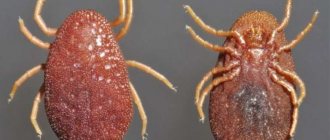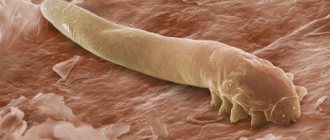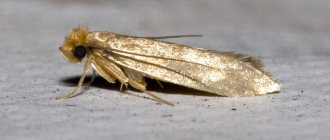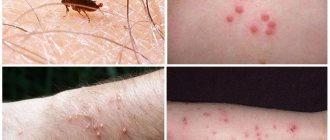With the onset of the warm season, the number of diseases caused by tick bites in cats increases sharply. With the onset of spring, pet owners begin to worry about how to protect their pet from this problem by any means. A tick bite in itself is not so terrible for a cat; dangerous pathogens are contained in the tick’s saliva, which can cause a number of dangerous and sometimes fatal diseases for a cat. Cats that walk through tall grass or dense bushes are especially at risk, where they are especially likely to pick up ticks. The tick that has just attached itself to the cat's skin is about the size of a pinhead. Over time, after he drinks blood, he grows to the size of a bean and is impossible not to notice.
General information about ticks. Ticks (Acarina) are small (0.1-30 mm) arthropods of the arachnid class (Arachnoidea) belonging to the largest group in the arthropod subclass, their number reaches 50 thousand species, most of which do not cause any harm to humans and animals. Ticks that parasitize cats are usually classified as carnivorous parasites, leading to the development of allergies, dermatitis, bacterial and viral diseases. Some ticks that attack cats drink blood, others chew the skin, and others feed on skin secretions and lymph. Cats are most often parasitized by three types of ticks:
Ixodidae (Ixodidae) are the largest ticks, which in a hungry state reach 2-3 mm in length, and after sucking blood - up to 1-1.5 cm. Scabies (internal, ear).
Subcutaneous (demodectic).
Mouth organs (piercing, gnawing, cutting, sucking). In all ticks they are formed by the first two pairs of limbs, chelicerae and pedipalgi; in ixodid ticks they consist of a pair of cutting chelicerae and a hypostome (an outgrowth of the lower edge of the mouth opening, covered with spines), tracheal or cutaneous respiration. Eyes are usually absent, less often there are 1-2 pairs. The stomach is saccular, in blood-sucking ticks with blind outgrowths that fill with blood during blood sucking. The excretory organs are represented by a pair of Malpighian vessels. Blood-sucking ticks have well-developed salivary glands, the secretion of which prevents blood clotting. All ticks are dioecious. The difference between females and males is well expressed, fertilization is internal. Most ticks are oviparous. The six-legged larva is the most characteristic feature of ticks.
The life of a tick can be roughly divided into four stages: egg, larva, nymph and adult. The total lifespan of a tick is about two months. After the tick drinks blood, it falls off and the larva begins to molt. Subsequently, the larva moves to the next stage of development, becoming a nymph; the nymph molts, turning into an adult tick, which is capable of leaving behind offspring. Ticks reproduce thanks to the female's ability to lay eggs. Considering that ticks that attack a cat multiply quickly and create optimal conditions for the development of bacteria and viruses, the owner should not delay treating the cat for ticks.
The process of a tick attacking a cat . Hungry ticks find their prey thanks to the presence of special thermal sensors. A cat passing by a bush or grass on which a tick is sitting becomes an object of attack; the tick makes a jump and, clinging to the hair, remains on the cat. Having latched onto a cat, the tick begins to look for a place on the body that is least covered with hair (skin around the ears, neck, legs, abdominal area, etc.). Further digging into the skin with its tentacles, the tick pierces the skin and begins the process of sucking blood. It becomes almost impossible to tear it away from the cat at this time, and only after the tick has completely drunk blood does it fall off the cat’s skin.
Types of ticks and their descriptions
The tick (Acari) does not belong to insects, as is commonly believed, but to arachnids, which represent the class of arthropods. There are many types of ticks, and they differ from each other in many ways, including their diet. Some species feed on decaying organic matter, others on plant juices, others on insects, etc. They can live in various conditions.
Interesting to know! Few people know that in addition to mites that live on the body of animals in the fur, cats can also have subcutaneous mites, which prefer to settle in the upper layers of the skin or in the ear canal. It is difficult to talk about all the diversity of parasites, of which there are about 1000 species.
In this case, it makes sense to talk about the most common parasites that can be found in both cats and female cats. For example:
- Ixodid ticks (forest ticks), which are distinguished by the fact that they can infect both animals and hosts with infectious diseases.
- Subcutaneous mites (scabies), which infect the upper layers of the animal's skin.
- Ear mites that appear in the ear canal of pets.
Piroplasmosis
Veterinarians have differing opinions regarding this disease. This is explained by the fact that ixodid ticks of the genus Rhipicephalus are found and parasitize wild cats in the jungle. Only a few species of parasites and isolated cases of infestations have been registered in Russia.
Weakened animals are susceptible to infection, and a dog (the main carrier of piroplasmosis) can become a source of infection for them. Siamese cats are susceptible to ticks.
Symptoms in case of invasion:
- temperature;
- anemia;
- feverish condition;
- vomit;
- constipation.
Ways of infection by ticks
There are many ways of infection, so no pet is immune from the appearance of parasites. For example:
- When the owner is with the animals in the park or forest.
- In cases of contact of a healthy animal with a sick one.
- Through contact with contaminated household items.
- The owner can also infect pets with various types of parasites.
This does not mean at all that a cat that practically never appears outside the apartment is protected from the appearance of ticks. When an animal develops blood-sucking parasites, its behavior and health status change noticeably. In this regard, it is recommended to regularly examine pets for parasites.
It is important to know! “Bloodsuckers” not only cause cats and cats a lot of discomfort, but can also infect them with dangerous diseases.
What complications are possible?
It should be understood that diseases caused by infection with subcutaneous mites cannot go away on their own. In order to prevent dangerous complications, it is necessary to pay more attention to the pet’s behavior and its general condition, and at the first symptoms, immediately contact the clinic.
Let's look at some possible complications:
- The healthy microflora of the body will be replaced by pathogenic ones.
- Formation of diseased hair follicles.
- Processes of chronic necrosis may develop.
- In advanced cases, tick infection can cause severe intoxication in the pet's body.
- The animal itself will appear vague and severely emaciated.
To prevent infection and possible complications, you should carefully monitor your pet’s hygiene and arrange visits to the veterinarian more often.
Subcutaneous mites
Demodex mites or hair mites settle in the upper layers of the skin, as well as in the follicles, and they select areas with the least drooping: on the head, on the neck, on the paws, in the eye area. Parasites can exist in an animal for many years without causing any harm and feeding on dead skin particles.
Demodex mites were first called eyelash or eye mites, which affected livestock. Over time, the parasite appeared in both pets and humans. Demodex mites can infect areas of human skin and also settle on eyelashes.
The tick begins to actively reproduce when a person or animal’s immunity decreases. The symptoms are as follows:
- As a result of the activity of ticks, the animal develops severe itching. As a result, the pet begins to itch constantly.
- There is less and less hair on the affected areas, even to the point of baldness.
- As a result of scratching, small wounds with a crust appear on the animal’s body, as well as festering blisters.
Symptoms of diseases caused by subcutaneous mites:
- Demodectic mange . It affects the upper layers of the skin and is accompanied by unbearable itching, as well as allergic reactions and the appearance of scars on the skin.
- Cat scabies or notoedrosis . As a result of this disease, the animal develops ulcers on the skin and large fistulas, which first appear in the head area and then spread throughout the body, leading to baldness. This type of disease can be transmitted to humans.
- Cheyletiellosis (walking dandruff) . It looks like dandruff formed into clumps containing quite a lot of small mites. When mites move inside the dandruff, they create the impression of movement. Signs of cheyletiellosis include the appearance of scaly nodules on the animal’s back, as well as baldness. The disease can also be transmitted from an animal to its owner.
- Sarcoptic mange (itchy scabies) first appears on the cat's face and gradually spreads throughout the body. As a result of this disease, scabs with crusts begin to appear. This process is accompanied by unbearable itching. Sarcoptoid mites in cats are a specific type of intradermal parasite. A pet can become infected with this type of tick through contact with sick animals, as well as from household items.
Treatment of a particular type of disease is carried out only on the basis of an accurate diagnosis, which is possible in a veterinary clinic. To do this, scrapings are taken from problem areas and the type of parasite is determined.
On a note! The earlier the diagnosis is made, the easier it is to cope with the disease. Mild forms of the disease are often cured by simply increasing the immunity of animals, which is associated with proper nutrition and care.
In cases where the disease is advanced and progresses, these methods of disposal are used.
- Animals are bathed in special shampoos.
- The hair on the affected areas is removed (cut), after which acaricidal preparations are used, in the form of ointments and drops of Fungin, Iruksovetin, Saphroderm, Amitrazine, etc.
- Bacterial lesions are treated with a course of antibiotics prescribed by a veterinarian.
- Increased immunity is associated with the use of vitamin complexes and supplements, such as Ligfol. The use of this drug allows you to stimulate regenerative processes in the body of animals, increase immunity, and accelerate wound healing.
- In cases of infection by fungal pathogens, the veterinarian prescribes Ivermentin subcutaneously.
- It is imperative to carry out preventive actions in relation to other pets that may have come into contact with the patient.
- The cat should be quarantined for up to a month.
- We should not forget about disinfecting the premises, as well as household items. For this purpose, acaricidal drugs like “Delta Zone” and others are used.
how to treat subcutaneous mites or demodicosis
Treatment of the generalized form
The generalized form is more difficult to treat and takes longer. First of all, it is necessary to eliminate the primary disease that caused the exacerbation of demodicosis. Without this, complete recovery of the animal is impossible. Veterinarians also advise completely trimming the cat to make it easier to treat with medications (since the disease covers almost the entire body). Next, the same methods are used as in the treatment of a localized form.
Often, veterinarians also prescribe a course of Dectomax or Cydectin injections. At the same time, the animal is prescribed injections of antibiotics - Kanamycin, Betamox, Baytril, Amoxicillin, etc.
It is also necessary to restore the cat’s immunity - the drug “Ligfol” will help here, as well as a vitamin and mineral complex. We draw special attention to the fact that treatment of this form of the disease should be carried out under the supervision of a specialist.
The appearance of ear mites in cats
Ear scabies or otodecosis is a disease when microscopic mites “Notoedres cati” settle in the ear canal of a cat. In such cases, the pet experiences constant discomfort, shakes its head and scratches its ears.
It is important to know! If you examine the ears of an animal, you can see dried elements of ticks in the form of crusts. At the same time, you can note their unpleasant odor.
If such foreign elements are detected, the following should be done:
- Mechanically free the ear canals from crusts by using disinfectant solutions based on furacillin, camphor alcohol or a solution of hydrogen peroxide (diluted).
- Give your cat vitamins and immunomodulatory components.
- Regularly instill medicated drops such as tsipam or otoferonol into your pet's ears. To evenly distribute the medicinal substance, you should massage the cat's ears.
- It is possible to administer a one-time injection of the drug Ivermen against ticks, which has an anthelmintic and arachno-entomocidal effect. Thanks to this injection, it is possible to get rid of the disease much faster. It is advisable to have a specialist give the injection, as you need to choose the right dosage.
- Wilkinson's ointment, which is based on an acaricidal substance, is used to treat the skin of the affected areas.
It will take at least a month of treatment to get rid of ear mites. After the disappearance of the main symptoms, the procedures should be continued for another week, no less.
Important fact! To prevent the animal from interfering with the procedures, a special cap is put on it. This will speed up the cat's healing process and also prevent scratching of the ears.
If the disease is not treated in time, it turns into otitis media with purulent discharge, which often leads to the death of the animal due to damage to the meninges.
Traditional methods of getting rid of ear mites in cats are effective in the initial stages of the disease. To clean the ears of animals, infusions of various herbs are used. For example:
- Green tea tincture. To prepare the product, you need to take 2 teaspoons of dry green tea and pour a glass of boiling water over it. The product must be cooled before use. A few drops (no more than 3) are instilled into each ear for a month and a half, depending on the severity of the lesion.
- Almond oil is used after cleaning the ears. After instillation, it is advisable to massage the ears.
- Using ointment prepared at home. To do this, take 3 tablespoons of vegetable oil and a clove of garlic. The cat's ear canals are lubricated with this ointment daily. In this case, you need to ensure that there are no allergies.
What does an ear mite look like in a cat, cat otodectosis symptoms video
Localized demodicosis
Treatment at home involves the use of specialized shampoos to wash the coat and effectively cleanse the skin. This shampoo should contain chlorhexidine or benzoyl peroxide. After washing, deformed skin is freed from marks and crusts using an antiseptic solution or H2O2.
The treated skin is dried. Special medications, Stronghold or Advocate, are applied to the pet’s skin in the area of the shoulder blades 2 to 4 times a month. Sometimes veterinarians recommend using Amitraz or Butox 50 in strict accordance with the instructions for it.
Areas of the body that have been damaged by subcutaneous mites are additionally treated with Citeal solution, but only with the permission of a veterinarian. The use of the product is completed by thoroughly washing the skin and drying it. The frequency of similar procedures should be from 2 to 4 times a day. When the crusts disappear from the affected areas, they continue to be treated with one of the medications recommended by the veterinarian. As a rule, we are talking about a special ointment.
When getting rid of keratinized crusts, it is convenient to cover the damaged areas of the skin with special oil solutions. Sometimes experts recommend using medications in the form of sprays. To exclude the occurrence of complications, therapy should be associated with the use of drugs to enhance immunity. The pet needs to restore its vitality, so you need to monitor its diet. The cat is given non-carbonated mineral water to speed up recovery.
Ixodid ticks: methods of control
From spring to the end of summer, quite dangerous representatives of arthropods - ixodid ticks - are active. The size of these parasites is not at all large, and they look similar in appearance to small spiders, while their body is covered with a chitinous shell. When it hits an animal, it moves around on the body for a couple of hours, looking for a suitable place to bite. A hungry parasite, if it has just appeared on a cat’s body, can be detected and destroyed.
When it digs into the body and begins to suck blood, the parasite increases in size to one and a half centimeters, while a hungry tick is not large in size, only 4 mm, no more.
Animals that frequently visit the street can easily “pick up” a tick in the grass or other thickets of vegetation. Sometimes a cat can get rid of parasites on its own, but there are times when it cannot do this.
It is important to know! The most evil, because hungry ixodid ticks are in the spring and autumn.
Ticks have a unique oral apparatus, which consists of a proboscis that can pierce human skin. After this, the parasite clings tightly to the skin and injects an anesthetic substance. Therefore, the cat does not feel the moment of the bite and the parasite can be detected only after a few hours, or even days. The longer a tick remains on an animal's body, the more difficult it is to get rid of it.
Ixodid ticks are particularly dangerous parasites that can infect an animal or person with terrible diseases. For example:
- Piroplasmosis. The disease is dangerous because the number of red blood cells in the blood decreases. As a result, general intoxication of the animal’s body manifests itself, body temperature rises, general weakness appears, and the animal refuses to eat. If effective treatment is not started in a timely manner, the animal will die.
- Hemobartonellosis. This disease is a form of infectious anemia. It can also cause chronic ailments of internal organs.
- Theileriosis or hemosporidiosis. As a result of the lesion, the functioning of the circulatory system is disrupted, which provokes hemorrhages and blockage of blood vessels and further death of the animal.
- Tularemia, which provokes damage to the lymph nodes, intoxication of the body and blood poisoning. Possible death of the pet.
- Worm eggs, which is the most common problem.
Folk remedies
In parallel with traditional ones, alternative methods of therapy are used. folk recipes against askariasis:
- Infusion of leather mackerel. 1 tablespoon of dry herb is poured into about 5 liters of boiling water and set aside until it cools completely. The strained solution is diluted with 0.5 liters of water and the pet is bathed. The plant has a bactericidal effect and promotes rapid healing of wounds.
- Wounds are treated with calendula tincture. To avoid side effects, it is better to buy the product at a pharmacy and use it according to the instructions.
- Treatment of wounds with concentrated chamomile infusion. To prepare it, 100 dry plants are poured with boiling water. The cooled infusion is filtered.
Be sure to read:
Worms in cats: causes, types, symptoms, what to do, the best medications and folk remedies
It is forbidden to treat leather with kerosene. The substance causes severe intoxication.
How to get rid of ticks from an animal?
When a tick digs into the skin and begins to become saturated with blood, then most often it becomes noticeable, since it significantly increases in size. In order to rid your cat of the parasite without consequences, you must adhere to a number of rules. For example:
- First of all, you need to protect yourself to avoid contact with the parasite. To do this, just wear rubber gloves and then wash your hands thoroughly.
- It is not recommended to drip oil or other substances onto the parasite, as this can lead to premature infection.
- To remove a tick from a cat, you will have to use special Tik Twister tweezers. This will allow you to remove the entire tick without any consequences.
- Using a thread for this requires great skill, otherwise the tick can be torn apart, damaging it.
- If the head of the parasite still remains under the skin, then it is better to treat the wound with an antiseptic. This is the only way to avoid infection.
- If the tick is pulled out entirely and remains alive, it is better to send it to the laboratory for analysis.
- To destroy a removed tick, it is better to place it in a jar of alcohol. Under no circumstances should it be crushed. Even after being flushed down the toilet, they do not die due to the “air sac”.
HOW TO REMOVE A TICK FROM A CAT
The tick has been removed, what next?
Cats are at much lower risk of contracting any of the diseases compared to dogs. Symptoms of infection appear in cats after 2-3 weeks. During this period of time, it is necessary to carefully monitor the behavior of a pet that has been bitten by a tick.
It is important to know! Young kittens, due to their still weak immunity, are most susceptible to the negative effects of tick bites.
Symptoms of infection may include fever, apathy, loss of appetite, weight loss, diarrhea or vomiting, cough, shortness of breath, pink urine, etc.
When the first negative signs of consequences appear, you should immediately contact a veterinarian. The doctor will be able to make an accurate diagnosis and prescribe the correct treatment. A positive treatment outcome depends on many factors, including the timeliness of treatment.
First aid for a bite
It is more important for owners of cats with access to the street to know what to do if the cat is bitten by a tick that lives in the forests. This type of tick is easier to detect; it is bright in color and clearly visible to the naked eye. After the tick attaches itself to the victim, only its head appears under the skin. The tick feeds on blood, so over time the body remaining above the surface of the skin swells to an unexpectedly large size for such a small (about the size of a pinhead) insect.
Such parasites are especially active in spring and early summer, so animals that spend a lot of time outside should be examined daily. You need to especially carefully feel and examine the pet’s head, legs, areas around the neck and ears.
If a tick is found, it must be removed. In the place where the tick has penetrated, you need to drop vegetable or camphor oil, alcohol or kerosene. Then carefully, turning or shaking the body of the parasite with tweezers or Tick Twister, remove it along with the head and proboscis. After surgery, the affected areas should be treated with iodine.
Manifestations of a forest tick bite can be different - from skin irritation to diseases transmitted to humans.
Preventive actions
Naturally, protecting a pet 100% from parasites is an unrealistic task, especially if the cat constantly visits the street. There are also no vaccinations against parasites. There is only one way out - this is the use of chemicals that are added to sprays, drops, and also used to treat collars.
In this regard, it is permissible to fight ticks using various methods that prevent attacks by parasites. For example:
- Use a special tick and flea collar that repels parasites with its scent.
- Use special drops that destroy ticks that managed to get onto the animal’s body. Such drugs can protect the animal for 3 months.
Despite the use of such preventive measures, it will still not be possible to protect completely, although they significantly reduce the likelihood of ticks appearing on the body of cats, especially from spring to early autumn.
Prevention
Preventing ticks from infesting cats by preventing contact with their relatives is almost impossible. The only way out is to prevent tick attacks on cats by using flea collars, drops and water-soluble emulsions.
If there are unfavorable areas for ticks in your area, they should be avoided. Before letting your cat into your apartment, you need to thoroughly comb out the fur with a fine comb and inspect the belly, paws, chest and ears for ticks.
Given that mites have the ability to survive for some time outside the cat's body, owners must protect their animals from re-infestation.
It is better to burn low-value items in the apartment, treat the floors with an acaricidal spray and wash them thoroughly.
Regular deworming, vaccination, disinfestation, and adequate feeding will provide the cat with strong immunity, which will not allow ticks that have fallen on the cat to actively reproduce.











